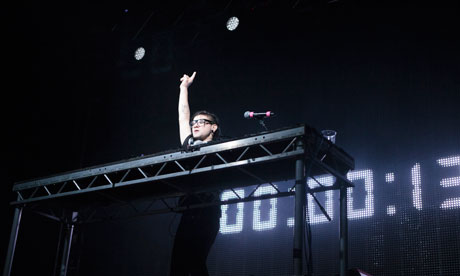
Here they come – the tiger-print leggings, the vest tops, the T-shirts soon to be removed. It is 8.40pm. This 80-year-old art deco venue in Glasgow's Gorbals already has sweat dripping from the ceiling. The 24-year-old Californian playing tonight is not even on yet; a Bob Marley "best of" is getting the crowd going instead. This may seem strange if you've heard, rightly so, that the Californian plays brain-blistering electronic music. It won't if you've heard his two-day-old collaboration with the late reggae star's son, Damian, or realised that the music made by Sonny Moore – for he is Skrillex – is becoming the mainstream.
At 9pm sharp, the stage screen lights up. A countdown starts over games-console imagery of outer space and smoky skies. A chap all in black, one half of his head shaved, the other lank with long locks, climbs scaffolding like a builder from Mars. Then it comes: the squelching sine waves, the processed whack of the beat, and then the thing everyone is here for, the bass. As it drops, bellies shake, tonsils quiver, and four paper cannons blow. Then come the smoke machines. We're in the show's first five minutes.
Skrillex splits opinions on a grand scale. This is partly thanks to his music's utter lack of subtlety – everything tonight sounds Ritalin-fuelled, then cranked up to 11, Spinal Tap-style. The rest requires biography. Moore began his career as the emo/nu-metal frontman of From First to Last, before falling for Daft Punk, Aphex Twin and laptop production. Then he got into dubstep, and started to co-opt its textures. This made him public enemy number one on dubstep forums, especially among underground fans. It got worse when the crowds started to come. In the last year, he's won Grammys, squired fresh-faced UK singer Ellie Goulding, collaborated with the Doors. In short, he fits in nowhere and everywhere. And doesn't seem to care.
The best recent attempt to describe Skrillex came from US critic Maura Johnston, who described his music as "the logical next step for people into hyperaggressive, ball-busting rock, [at least] a progression more logical than … Ad agency-approved rock". She's right. Tonight, Skrillex's aural onslaught has a menace, and an anti-mainstream edge, that rock sometimes has. But he also snares pop kids and ravers with his skronky, poppy hooks; his crowd is a cross-section of British youth (I spot only one other person over 25, keeping a terrified eye on his son). His music is a melange too – of electro, trance, eight-bit computer noises and experimental effects, dubstep burbling away somewhere within that fusillade.
Essentially, this is musical manna for the all-access, all-shuffle generation. Its relentless pace also quickly feels samey, but it's hard not to be jolted by it, metaphorically and literally. Lyrics are minimal, only slogans to be chanted by the crowd ("Breakin' a Sweat" gets the crowd hollering "it's all right, it's all right"; the propulsive "Rock and Roll" also gets them shouting its title). Skrillex barely sings these days; Autotuned female vocals usually do that work for him. This can become disconcerting, especially when footage of behind-shaking women in bikinis fill the screen behind him. This boy's own world has little respect for the opposite sex, although the girls in the crowd, hair dripping, mascara streaming down their faces, might disagree.
Skrillex is certainly entertaining to watch. For 90 minutes, he pogoes behind his equipment – two mixers, a multi-format player and a pad controller – like a demented sprite. There is something sweet about him too. When he requests some "fucking noise", he sounds driven by excitement, not ego. Asking "how y'all my balcony people doing?", he sounds oddly polite. He also likes crowd-pleasing; his encore imagery begins with a Braveheart clip, followed by a huge Scottish flag. Cheesy as a fondue party? Yes. Clangingly effective? Certainly.
His set approaches the final flag with the relative subtlety of "Breathe", which recalls Jean-Michel Jarre, and that box-fresh Marley collaboration, "Make it Bun Dem" – the crowd knows it already, of course. Then comes "Scary Monsters and Nice Sprites", its riff more persuasive than all that's come before, its gurgles absurdly belly-deep. The ceiling-sweat becomes a rainstorm. Young men's chests are wet patchworks of cannoned paper. You sense this is how low bass can go, and how high it can feel, and how far it has reached out.

